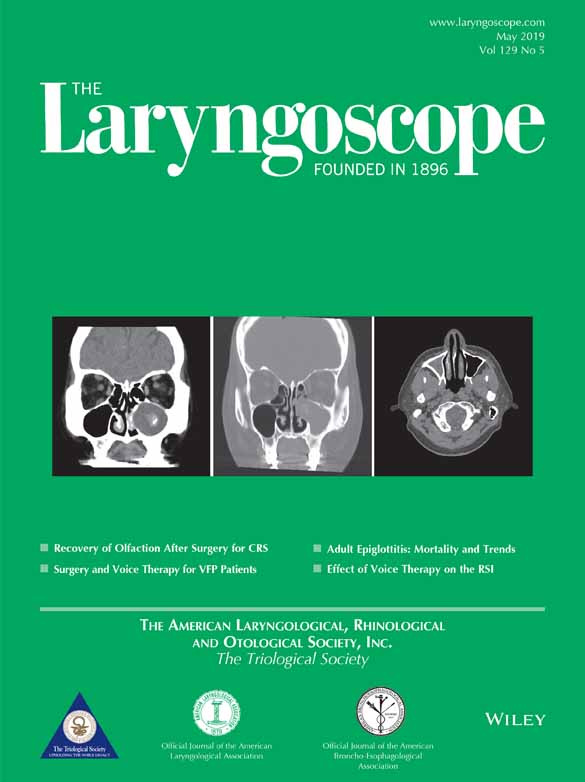In Response to pH-Neutralizing Esophageal Irrigations as a Novel Mitigation Strategy
Rachel R. Anfang
Sidney Kimmel Medical College, Thomas Jefferson University, Philadelphia, Pennsylvania
Search for more papers by this authorCorresponding Author
Kris R. Jatana MD
Department of Otolaryngology–Head and Neck Surgery, Nationwide Children's Hospital and Wexner Medical Center at Ohio State University, Columbus, Ohio
Send correspondence to Kris R. Jatana, MD, Pediatric Otolaryngology, Nationwide Children's Hospital, 555 South 18th Street, Suite 2A, Columbus, OH 43205. Ph: 614-722-6600; Fax: 614-722-6609; E-mail: [email protected]Search for more papers by this authorRebecca L. Linn MD
Division of Anatomic Pathology, Department of Pathology and Laboratory Medicine, Children's Hospital of Philadelphia, Philadelphia, Pennsylvania
Search for more papers by this authorKeith Rhoades BS
Intertek Product Intelligence Group Inc., Arlington Heights, Illinois
Search for more papers by this authorJared Fry BS
Intertek Product Intelligence Group Inc., Arlington Heights, Illinois
Search for more papers by this authorIan N. Jacobs MD
Division of Otolaryngology, Department of Surgery, Children's Hospital of Philadelphia, Philadelphia, Pennsylvania
Department of Otorhinolaryngology–Head and Neck Surgery, Perelman School of Medicine at the University of Pennsylvania, Philadelphia, Pennsylvania
Search for more papers by this authorRachel R. Anfang
Sidney Kimmel Medical College, Thomas Jefferson University, Philadelphia, Pennsylvania
Search for more papers by this authorCorresponding Author
Kris R. Jatana MD
Department of Otolaryngology–Head and Neck Surgery, Nationwide Children's Hospital and Wexner Medical Center at Ohio State University, Columbus, Ohio
Send correspondence to Kris R. Jatana, MD, Pediatric Otolaryngology, Nationwide Children's Hospital, 555 South 18th Street, Suite 2A, Columbus, OH 43205. Ph: 614-722-6600; Fax: 614-722-6609; E-mail: [email protected]Search for more papers by this authorRebecca L. Linn MD
Division of Anatomic Pathology, Department of Pathology and Laboratory Medicine, Children's Hospital of Philadelphia, Philadelphia, Pennsylvania
Search for more papers by this authorKeith Rhoades BS
Intertek Product Intelligence Group Inc., Arlington Heights, Illinois
Search for more papers by this authorJared Fry BS
Intertek Product Intelligence Group Inc., Arlington Heights, Illinois
Search for more papers by this authorIan N. Jacobs MD
Division of Otolaryngology, Department of Surgery, Children's Hospital of Philadelphia, Philadelphia, Pennsylvania
Department of Otorhinolaryngology–Head and Neck Surgery, Perelman School of Medicine at the University of Pennsylvania, Philadelphia, Pennsylvania
Search for more papers by this author
BIBLIOGRAPHY
- 1Anfang RR, Jatana KR, Linn RL, Rhoades K, Fry J, Jacobs IN. pH-neutralizing esophageal irrigations as a novel mitigation strategy for button battery injury [published online June 11, 2018]. Laryngoscope doi: 10.1002/lary.27312.
- 2National Capital Poison Center button battery ingestion triage and treatment guideline. Available at: https://http://www.poison.org/battery/guideline. Updated June 2018. Accessed November 1, 2018.
- 3Soto PH, Reid NE, Litovitz TL. Time to perforation for button batteries lodged in the esophagus [published online July 18, 2018]. Am J Emerg Med doi: 10.1016/j.ajem.2018.07.035.
- 4Shepherd KE, Faulkner CS, Leiter JC. Acute effects of sucralfate aspiration: clinical and laboratory observations. J Clin Anesth 1994; 6: 119–123.
- 5Yildizdas D, Yapicioglu H, Yilmaz HL. Occurrence of ventilator-associated pneumonia in mechanically ventilated pediatric intensive care patients during stress ulcer prophylaxis with sucralfate, ranitidine, and omeprazole. J Crit Care 2002; 17: 240–245.
- 6Reveiz L, Guerrero-Lozano R, Camacho A, Yara L, Mosquera PA. Stress ulcer, gastritis, and gastrointestinal bleeding prophylaxis in critically ill pediatric patients: a systematic review. Pediatr Crit Care Med 2010; 11: 124–132.




